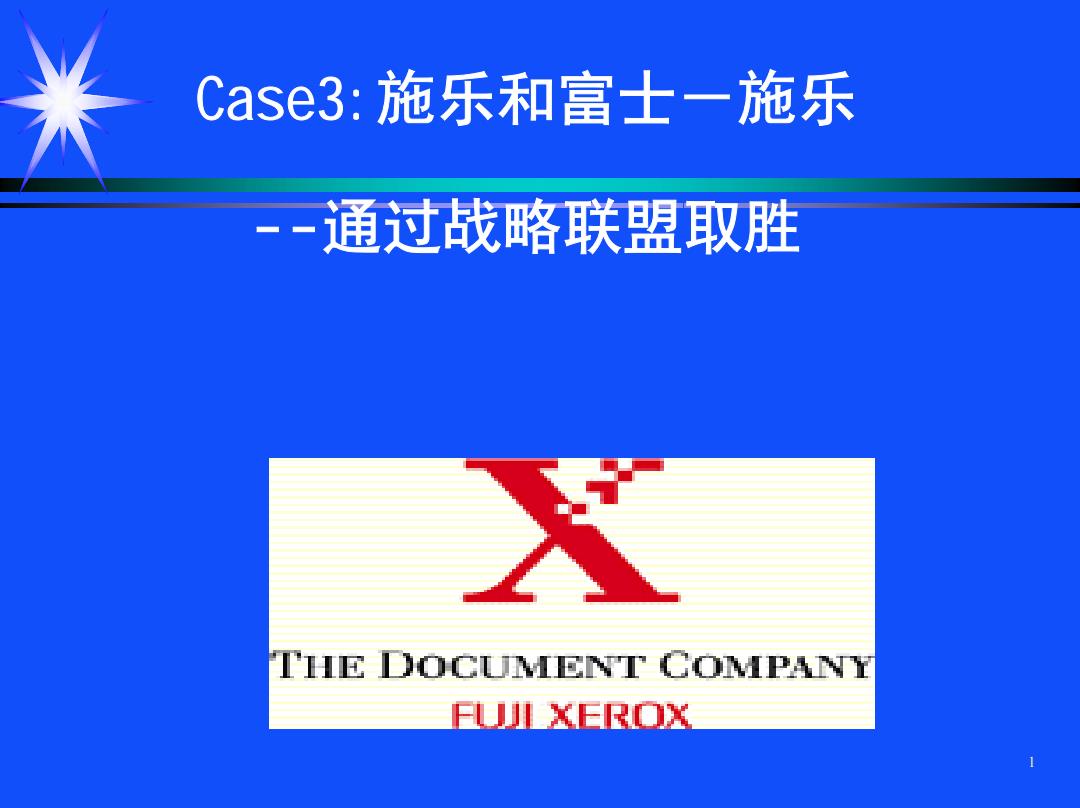
CaSe3:施乐和富士一施乐 --通过战略联盟取胜 THE DOCUMENT COMPANY 且川XEROX 1
1 Case3:施乐和富士-施乐 --通过战略联盟取胜

Synopsis (I) Many of the international alliances being formed today are still too young for us to evaluate their full impact. The case of Xerox and Fuji Xerox gives us a unique opportunity to trace the evolution of such an alliance over a long period of time.We can learn a lot from this experience,and try both to avoid Xerox's mistakes and copy Xerox's success. 2
2 Synopsis (I) Synopsis (I) Many of the international alliances being formed today are still too young for us to evaluate their full impact. The case of Xerox and Fuji Xerox gives us a unique opportunity to trace the evolution of such an alliance over a long period of time. We can learn a lot from this experience, and try both to avoid Xerox’s mistakes and copy Xerox’s success
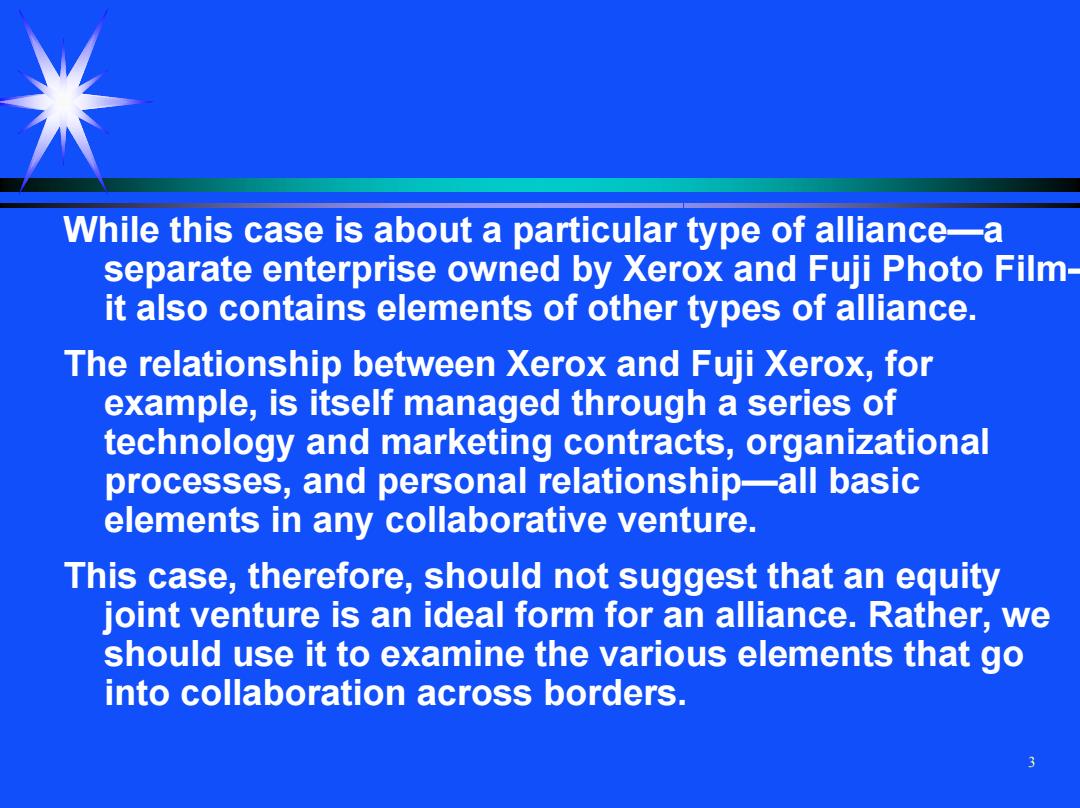
While this case is about a particular type of alliance-a separate enterprise owned by Xerox and Fuji Photo Film- it also contains elements of other types of alliance. The relationship between Xerox and Fuji Xerox,for example,is itself managed through a series of technology and marketing contracts,organizational processes,and personal relationship-all basic elements in any collaborative venture. This case,therefore,should not suggest that an equity joint venture is an ideal form for an alliance.Rather,we should use it to examine the various elements that go into collaboration across borders. 3
3 While this case is about a particular ty p e of alliance—a separate enterprise owned b y Xerox and Fuji Photo Film — it also contains elements of other t ypes of alliance. The relatio nship bet ween Xerox and Fuji Xerox, for example, is itself managed through a series of technology and marketing contracts, organizational processes, and personal relationship—all basic elements in an y collaborative venture. This case, therefore, should not suggest that an equity joint venture is an ideal form for an alliance. Rather, w e should use it to examine the various ele ments that go into collaboration across borders
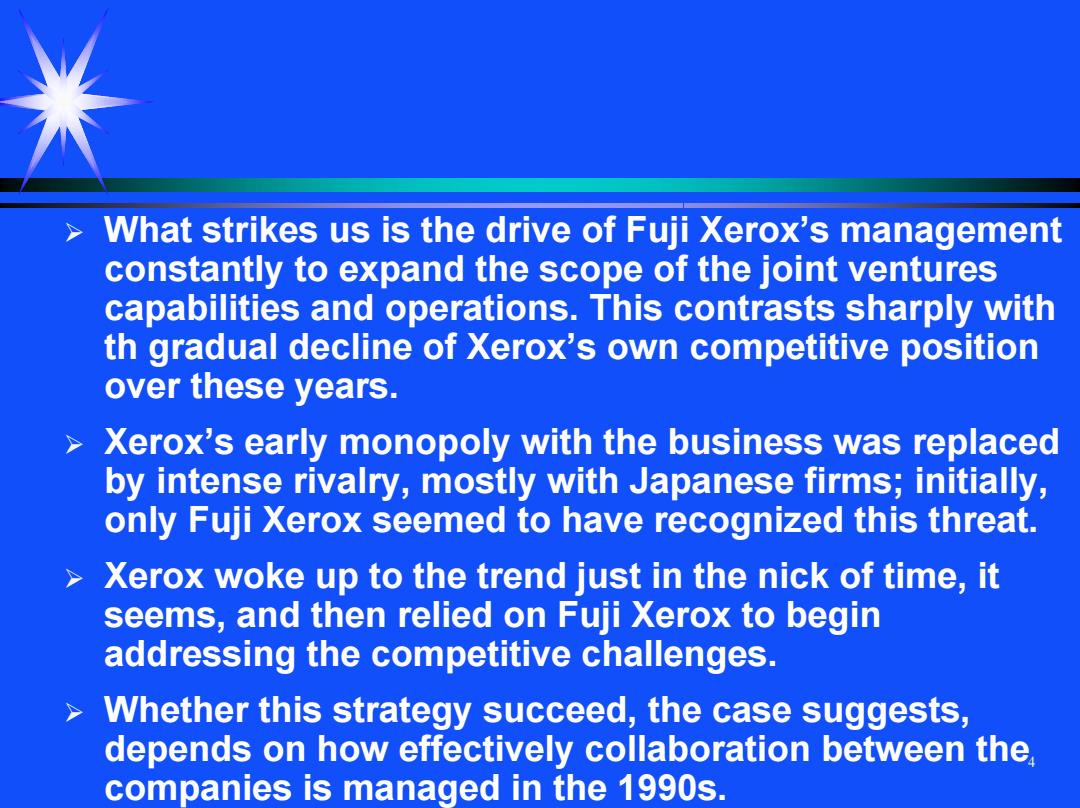
What strikes us is the drive of Fuji Xerox's management constantly to expand the scope of the joint ventures capabilities and operations.This contrasts sharply with th gradual decline of Xerox's own competitive position over these years. Xerox's early monopoly with the business was replaced by intense rivalry,mostly with Japanese firms;initially, only Fuji Xerox seemed to have recognized this threat. Xerox woke up to the trend just in the nick of time,it seems,and then relied on Fuji Xerox to begin addressing the competitive challenges. > Whether this strategy succeed,the case suggests, depends on how effectively collaboration between the. companies is managed in the 1990s
4 ¾ What strikes us is the drive of Fuji Xerox’s management constantly to expand the scope of the joint ventures capabilities and operations. This contrasts sharply with th gradual decline of Xerox’s own competitive position over these years. ¾ Xerox’s early monopoly with the business was replaced by intense rivalry, mostly with Japanese firms; initially, only Fuji Xerox seemed to have recognized this threat. ¾ Xerox woke up to the trend just in the nick of time, it seems, and then relied on Fuji Xerox to begin addressing the competitive challenges. ¾ Whether this strategy succeed, the case suggests, depends on how effectively collaboration between the companies is managed in the 1990s
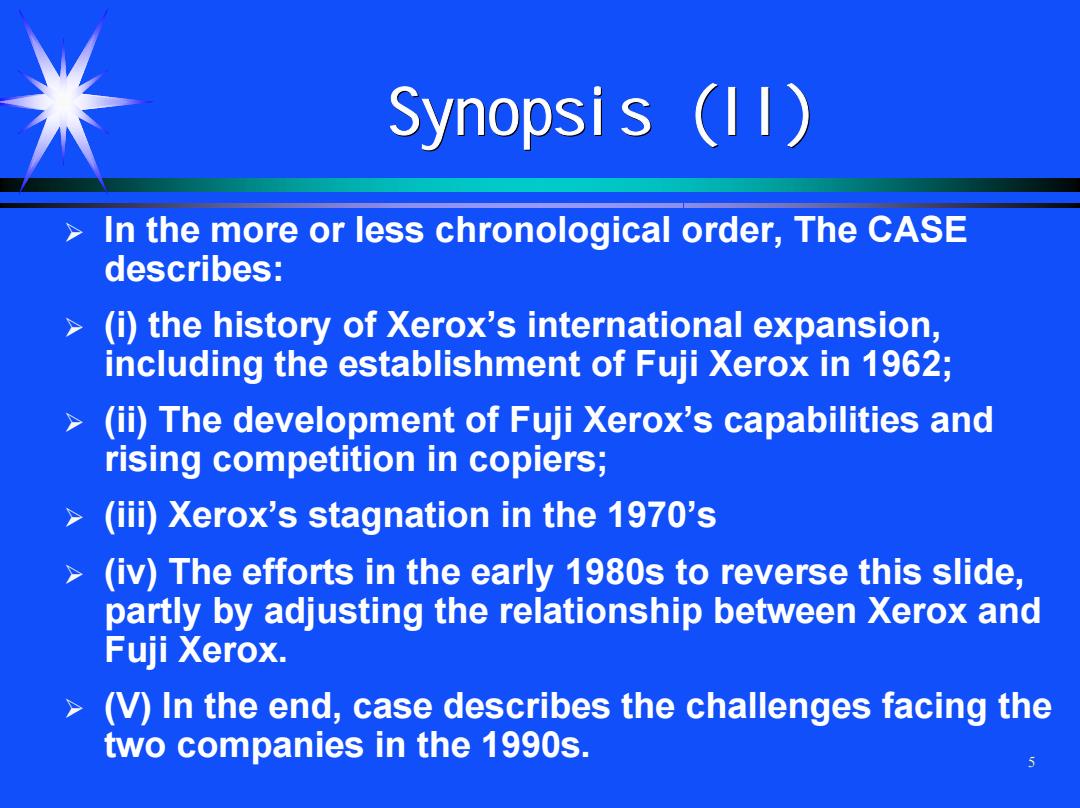
Synopsis (I1) In the more or less chronological order,The CASE describes: > (i)the history of Xerox's international expansion, including the establishment of Fuji Xerox in 1962; (ii)The development of Fuji Xerox's capabilities and rising competition in copiers; (iii)Xerox's stagnation in the 1970's (iv)The efforts in the early 1980s to reverse this slide, partly by adjusting the relationship between Xerox and Fuji Xerox. (V)In the end,case describes the challenges facing the two companies in the 1990s. 5
5 Synopsis (II) Synopsis (II) ¾ In the more or less chronological order, The CASE describes: ¾ (i) the history of Xerox’s international expansion, including the establishment of Fuji Xerox in 1962; ¾ (ii) The development of Fuji Xerox’s capabilities and rising competition in copiers; ¾ (iii) Xerox’s stagnation in the 1970’s ¾ (iv) The efforts in the earl y 1980s to reverse this slide, partl y by adjusting the relationship bet w e en Xerox and Fuji Xerox. ¾ (V) In the end, case describes the challenges facing the two companies in the 1990s

Learni ng obj ecti ves This case is about managing strategic alliances, even though the case is about equity joint venture,it illustrates issues in the management of other types of alliances too. Firstly,we should pay more attention on dynamics of international alliances.These include: how partners learn through alliances, How alliances grew and develop,and how the relationship between partners evolves in response to external and internal changes. 6
6 Learning objectives Learning objectives This case is about managing strategic alliances, even though the case is about equity joint venture, it illustrates issues in the management of other types of alliances too. Firstly, w e should pay more attention on dynamics of internation al a llianc es. These inc lude: ¾ how partners learn thr ough alliances, ¾ How alliances grew and develop, and how the rela tionship between partners evolv es in response to external and internal changes

Second,appropriate measures of alliance performance and underlying success factors may change dramatically over the life of an alliance. Third,there Is often a serious tradeoff between giving local autonomy to an alliance and integrating into a parent's global strategy. Fourth,the structure and substance of collaboration needs to change in response to change in the external environment and in the capabilities and goals of the partners. Final,different sets of factors drive collaboration in marketing, research,and manufacturing,even though the success of collaboration in one functional area often depends on that in another
7 ¾ Second, appropriate measures of alliance performance and underlying success factors may change dramatically over the life of an alliance. ¾ Third, there Is often a serious tradeoff between giving local autonomy to an alliance and integrating into a parent’s global strategy. ¾ Fourth, the structure and substance of collaboration needs to change in response to change in the external environment and in the capabilities and goals of the partners. ¾ Final, different sets of factors drive collaboration in marketing, research, and manufacturing, even though the success of collaboration in one functional area often depends on that in another

Analysis and Discussion Structure 1.Performance of the alliance before 1990 2.Future options for collaboration >3.Globalization and Organizational Structure >4.Conclusion 8
8 Analysis and ysis and Discussion Structure ussion Structure ¾ 1. Performance of the alliance before 1990 ¾ 2. Future options for collaboration ¾ 3. Globalization and Organizational Structure ¾ 4. Conclusion
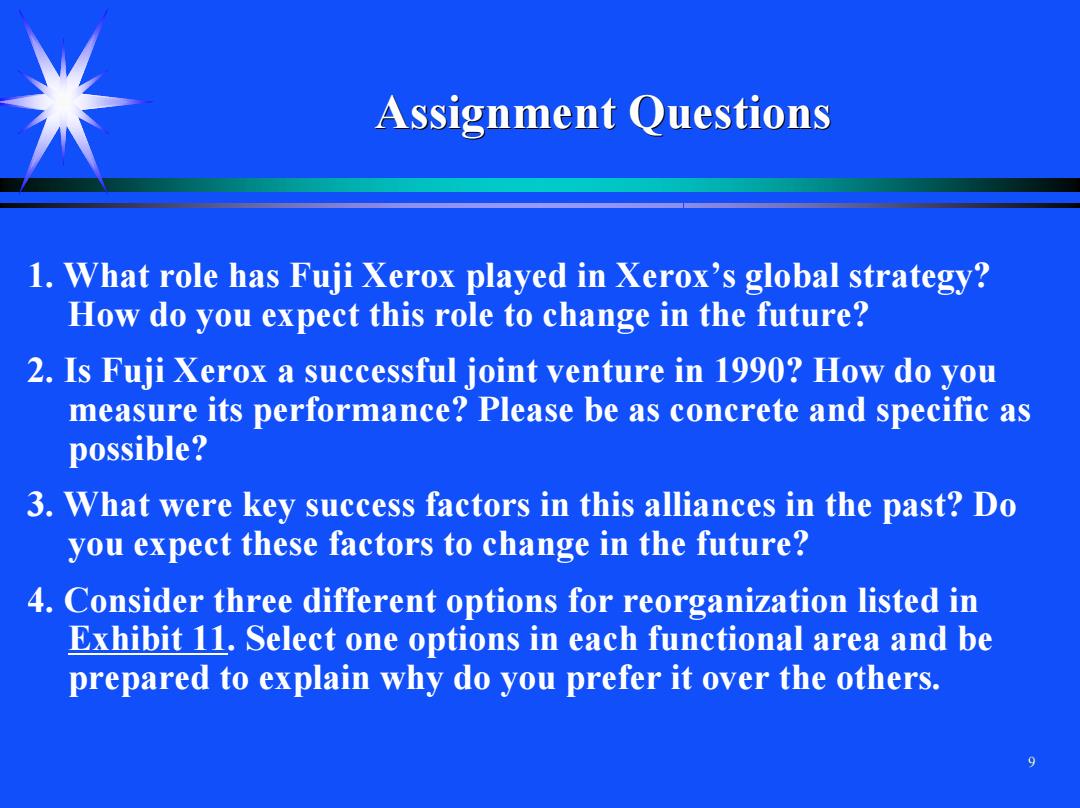
Assignment Questions 1.What role has Fuji Xerox played in Xerox's global strategy? How do you expect this role to change in the future? 2.Is Fuji Xerox a successful joint venture in 1990?How do you measure its performance?Please be as concrete and specific as possible? 3.What were key success factors in this alliances in the past?Do you expect these factors to change in the future? 4.Consider three different options for reorganization listed in Exhibit 11.Select one options in each functional area and be prepared to explain why do you prefer it over the others. 9
9 Assignment Ques nt Questions 1. What role has Fuji Xerox played in Xerox’s global strategy? How do you expect this role to change in the future? 2. Is Fuji Xerox a successful joint venture in 1990? How do you measure its performance? Please be as concrete and specific as possible? 3. What were key success factors in this alliances in the past? Do you expect these factors to change in the future? 4. Consider three different options for reorganization listed in Exhibit 11. Select one options in each functional area and be prepared to explain why do you prefer it over the others

1.Performance of the alliance before 1990 10
10 1. Performance of the 1. Performance of the alliance bef ance before 1990 re 1990